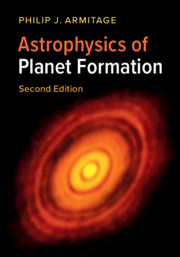Book contents
- Frontmatter
- Contents
- Preface
- 1 Observations of Planetary Systems
- 2 Protoplanetary Disk Structure
- 3 Protoplanetary Disk Evolution
- 4 Planetesimal Formation
- 5 Terrestrial Planet Formation
- 6 Giant Planet Formation
- 7 Early Evolution of Planetary Systems
- Appendix A Physical and Astronomical Constants
- Appendix B The Two-Body Problem
- Appendix C N-Body Methods
- References
- Index
5 - Terrestrial Planet Formation
Published online by Cambridge University Press: 27 January 2020
- Frontmatter
- Contents
- Preface
- 1 Observations of Planetary Systems
- 2 Protoplanetary Disk Structure
- 3 Protoplanetary Disk Evolution
- 4 Planetesimal Formation
- 5 Terrestrial Planet Formation
- 6 Giant Planet Formation
- 7 Early Evolution of Planetary Systems
- Appendix A Physical and Astronomical Constants
- Appendix B The Two-Body Problem
- Appendix C N-Body Methods
- References
- Index
Summary
Chapter 5 focuses on the formation of rocky planetary-scale bodies, including terrestrial planets, super-Earths, and giant planet cores. The concepts of gravitational focusing, shear and dispersion dominated encounters, and catastrophic disruption are introduced. A simple "particle in a box" statistical model for planetary growth is described, along with the ideas of orderly, runaway, and oligarchic growth. Factors that determine the planetesimal velocity dispersion, including viscous stirring, dynamical friction, and gas drag, are discussed. The regimes of pebble accretion, the conditions under which it operates, and the pebble accretion rate, are discussed. The standard model for the final assembly of the Solar System's terrestrial planets is outlined.
- Type
- Chapter
- Information
- Astrophysics of Planet Formation , pp. 181 - 219Publisher: Cambridge University PressPrint publication year: 2020

